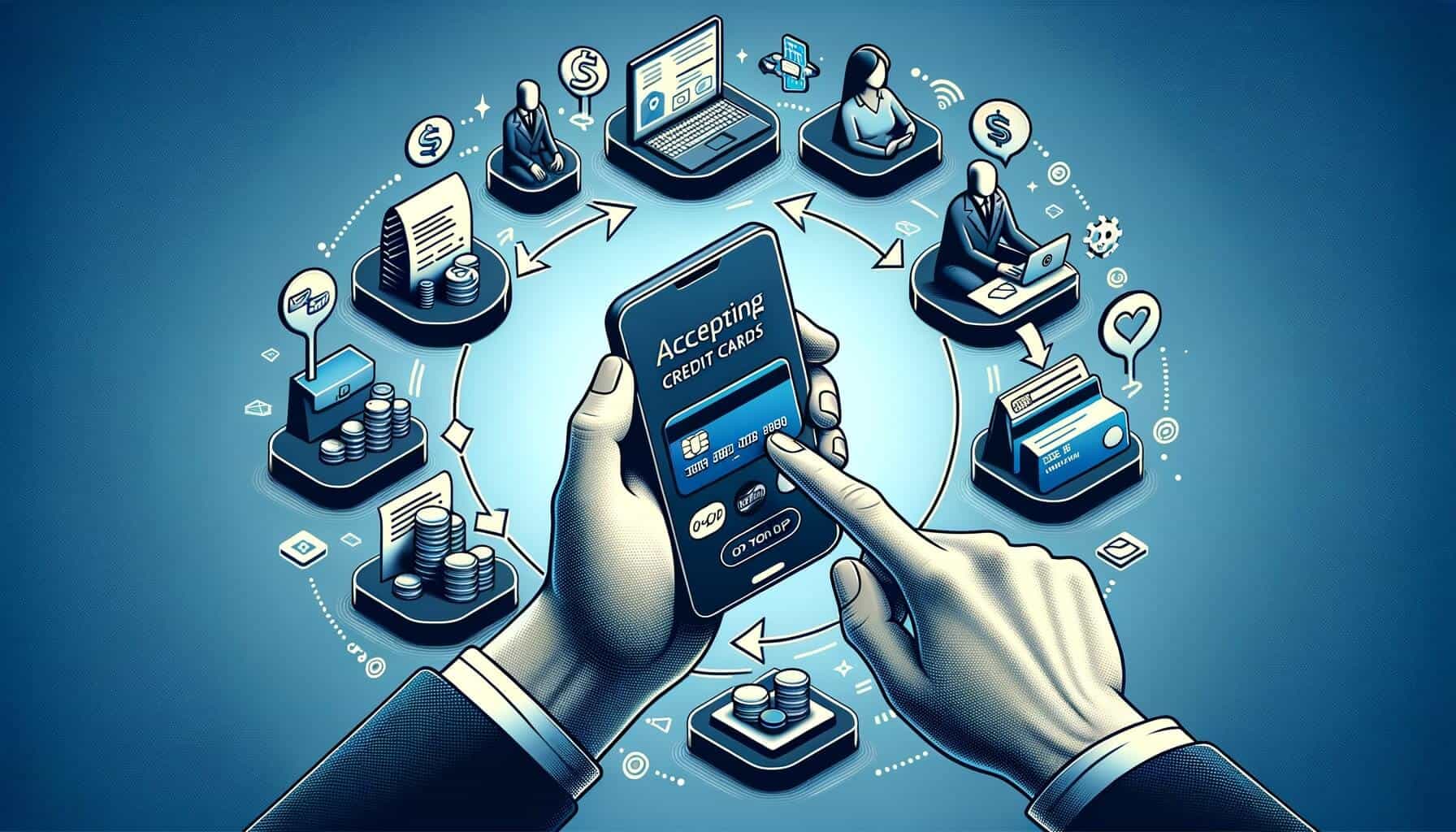
By Crystal Hopkins January 9, 2025
In today’s digital age, accepting credit cards over the phone has become an essential part of running a successful business. Whether you operate a small business or a large corporation, providing customers with the convenience of making payments over the phone can significantly enhance their overall experience. However, it is crucial to understand the basics of accepting credit cards over the phone to ensure a seamless and secure transaction process.
Accepting credit cards over the phone involves collecting payment information from customers and processing the transaction manually. This method allows businesses to accept payments without the need for a physical card or an in-person transaction. By accepting credit cards over the phone, businesses can expand their customer base and cater to individuals who prefer making purchases remotely.
Understanding the Basics of Accepting Credit Cards

Before diving into the specifics of accepting credit cards over the phone, it is important to have a solid understanding of the basics. Credit card processing involves several parties, including the merchant, the customer, the acquiring bank, and the payment gateway.
When a customer makes a purchase over the phone, the merchant collects the customer’s credit card information and submits it to the acquiring bank for authorization. The acquiring bank then communicates with the customer’s issuing bank to verify the transaction. If approved, the funds are transferred from the customer’s account to the merchant’s account.
Setting Up a Merchant Account for Phone Payments

Before you can start accepting credit cards over the phone, you need to set up your business to facilitate this payment method. Here are some essential steps to follow:
1. Obtain a merchant account: To accept credit card payments, you need to establish a merchant account with a payment processor. This account will enable you to process credit card transactions and receive funds in your business bank account.
2. Choose a payment gateway: A payment gateway acts as a bridge between your business, the customer, and the payment processor. It securely transmits payment information and ensures that transactions are processed smoothly.
3. Acquire a virtual terminal: A virtual terminal is a web-based application that allows you to manually enter credit card information and process payments over the phone. It provides a user-friendly interface for inputting customer details and initiating transactions.
4. Train your staff: It is essential to train your staff on how to handle credit card transactions over the phone. They should be familiar with the virtual terminal, understand security protocols, and be able to assist customers effectively.
Choosing the Right Payment Processor for Phone Transactions

Selecting the right payment processor is crucial for smooth and secure credit card transactions over the phone. Here are some factors to consider when choosing a payment processor:
1. Security: Look for a payment processor that prioritizes security and offers robust encryption and fraud prevention measures. This ensures that customer data is protected during the transaction process.
2. Compatibility: Ensure that the payment processor you choose is compatible with your virtual terminal and other systems you use for your business operations. Seamless integration between systems will streamline the payment process.
3. Pricing: Compare pricing structures and fees offered by different payment processors. Look for transparent pricing models that align with your business’s needs and budget.
4. Customer support: Consider the level of customer support provided by the payment processor. Responsive and knowledgeable support can be invaluable in resolving any issues that may arise during credit card transactions.
Ensuring Security and Compliance in Phone Credit Card Transactions

Security and compliance are paramount when accepting credit cards over the phone. To protect your customers’ sensitive information and maintain regulatory compliance, follow these guidelines:
1. PCI DSS compliance: Ensure that your business is compliant with the Payment Card Industry Data Security Standard (PCI DSS). This set of security standards helps protect cardholder data and prevent fraud.
2. Encryption: Use encryption technology to secure customer data during transmission. This ensures that credit card information cannot be intercepted or accessed by unauthorized individuals.
3. Secure storage: Implement secure storage practices for customer data. Avoid storing sensitive credit card information unless absolutely necessary, and ensure that any stored data is encrypted and protected.
4. Employee training: Train your employees on security protocols and best practices for handling credit card information. Emphasize the importance of safeguarding customer data and the potential consequences of non-compliance.
Step-by-Step Guide: Accepting Credit Cards Over the Phone
Now that you have a solid understanding of the basics and have set up the necessary accounts and systems, let’s walk through the step-by-step process of accepting credit cards over the phone.
Step 1: Gather the necessary information – Before accepting credit card payments over the phone, you will need to gather the necessary information from your customers. This typically includes the customer’s name, credit card number, expiration date, and CVV code.
Step 2: Verify the customer’s identity – To prevent fraud, it is important to verify the customer’s identity before processing the payment. This can be done by asking for additional information such as the customer’s billing address or by using a verification service.
Step 3: Enter the payment details – Once you have verified the customer’s identity, enter the payment details into your payment gateway or virtual terminal. This can typically be done through a web-based interface or a phone system that is integrated with your payment gateway.
Step 4: Obtain authorization – After entering the payment details, submit the transaction for authorization. The payment gateway will communicate with the acquiring bank to verify the transaction and obtain authorization.
Step 5: Record the transaction – Once the transaction is authorized, record the details of the transaction for your records. This can include the transaction amount, date and time, customer information, and authorization code.
Step 6: Process the payment – After recording the transaction, process the payment by capturing the funds from the customer’s account. This can typically be done through your payment gateway or by contacting your acquiring bank.
Step 7: Provide a receipt – Finally, provide the customer with a receipt for the transaction. This can be done by sending an email receipt or by mailing a physical receipt to the customer.
Best Practices for Efficient and Effective Phone Credit Card Processing
To ensure efficient and effective phone credit card processing, it is important to follow best practices. Here are some tips to help you streamline your processes and provide a seamless experience for your customers:
1. Train your staff – Properly train your staff on how to handle phone credit card transactions, including how to collect and protect customer information, how to use your payment gateway or virtual terminal, and how to troubleshoot common issues.
2. Use a secure phone system – Invest in a secure phone system that encrypts customer information and complies with industry standards. This will help protect your customers’ sensitive data and reduce the risk of fraud.
3. Implement fraud detection measures – Use fraud detection systems and tools to identify and prevent fraudulent transactions. This can include address verification services, CVV verification, and transaction monitoring.
4. Streamline the payment process – Make the payment process as simple and efficient as possible for your customers. Minimize the number of steps required to complete a transaction and provide clear instructions on how to enter payment details.
5. Offer multiple payment options – Give your customers the flexibility to choose their preferred payment method. In addition to credit cards, consider accepting alternative payment methods such as mobile wallets or bank transfers.
6. Provide excellent customer service – Ensure that your customer service team is knowledgeable and responsive. Be available to assist customers with any questions or issues they may have during the payment process.
Troubleshooting Common Issues in Phone Payment Processing
Despite your best efforts, you may encounter common issues when accepting credit cards over the phone. Here are some common issues and their potential solutions:
1. Declined transactions – If a transaction is declined, double-check the payment details entered and verify that the customer’s credit card is valid. If the issue persists, contact your payment gateway or acquiring bank for further assistance.
2. Technical difficulties – If you experience technical difficulties with your payment gateway or phone system, check for any system updates or outages. If the issue persists, contact your service provider for support.
3. Disputes and chargebacks – In the event of a dispute or chargeback, gather all relevant documentation and evidence to support your case. This can include transaction records, customer communication, and proof of delivery.
4. Security breaches – If you suspect a security breach or unauthorized access to customer information, immediately notify your payment gateway, acquiring bank, and any relevant authorities. Take steps to mitigate the breach and enhance security measures.
Frequently Asked Questions (FAQs)
Q1: Can I accept credit card payments over the phone without a merchant account?
No, you will need a merchant account to accept credit card payments over the phone. A merchant account is necessary to process and receive funds from credit card transactions.
Q2: How long does it take to set up a merchant account for phone payments?
The time it takes to set up a merchant account can vary depending on the provider and the complexity of your business. It can take anywhere from a few days to a few weeks to complete the application and approval process.
Q3: What are the fees associated with accepting credit cards over the phone?
The fees associated with accepting credit cards over the phone can vary depending on the provider and the type of transaction. Common fees include transaction fees, monthly fees, and chargeback fees.
Q4: How can I protect my customers’ credit card information during phone transactions?
To protect your customers’ credit card information, use secure phone systems that encrypt customer data. Additionally, comply with PCI DSS guidelines and implement measures such as encryption and tokenization.
Q5: Can I accept credit card payments over the phone internationally?
Yes, you can accept credit card payments over the phone internationally. However, it is important to ensure that your payment gateway and merchant account support international transactions and comply with local regulations.
Conclusion
Accepting credit cards over the phone is a valuable tool for businesses of all sizes. By understanding the basics, setting up a merchant account, choosing the right payment gateway, and ensuring security and compliance, you can provide a seamless and secure payment experience for your customers. By following best practices and troubleshooting common issues, you can streamline your processes and enhance customer satisfaction.
Remember to always prioritize the security of your customers’ sensitive information and stay up to date with industry regulations. With the right systems and practices in place, accepting credit cards over the phone can be a simple and efficient process that benefits both your business and your customers.